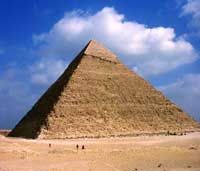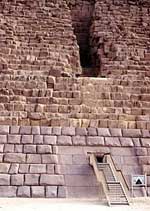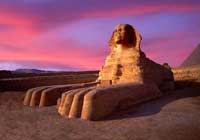|
The Pyramids & The Sphinx
 On the west bank of the Nile facing Cairo and on top of Giza
plateau rise the three pyramids erected by Cheops, Chephren and
Mycerinus, guarded by the mysterious Sphinx, which is a mythical
statue with the body of a lion and a human head. The three
pyramids and the Sphinx are considered one of the seven wonders
of the World and the most important tourist site in Egypt. On the west bank of the Nile facing Cairo and on top of Giza
plateau rise the three pyramids erected by Cheops, Chephren and
Mycerinus, guarded by the mysterious Sphinx, which is a mythical
statue with the body of a lion and a human head. The three
pyramids and the Sphinx are considered one of the seven wonders
of the World and the most important tourist site in Egypt.
The ancient Egyptian’s aim in building the pyramids was that
they should serve as sepulchers for their Pharaohs to preserve
their bodies, for they believed in resurrection and immortality.
 The Great
Pyramid of Cheops The Great
Pyramid of Cheops
King Khufu, who is also known by the Greek name "Cheops," was
the father of pyramid building at Giza. He ruled from 2589 -
2566 B.C. and was the son of King Sneferu and Queen Hetpeheres.
The pyramid was built in 2589-2566 B.C. and consists of
2,300,000 limestone and granite blocks of stone. The base is 13
square acres, 568,500 square feet. The length of each side of
the base is now 745 feet but used to be 754 feet. Total weight
of this pyramid is 6.5 million tons. The average weight of an
individual block of stone is 2.5 tons. The height of Cheops was
originally 146 meters, but has now become 137 meters after the
erosion of its summit. Going inside the pyramid, there is two
corridors, one ascending and the other descending. The latter
leading to an unfinished chamber below the pyramid. The
ascending corridor leads to another two corridors. The
horizontal one takes us to the semi-finished limestone Queen’s
chamber. The ascending one drives us through the Great Gallery
to the King’s chamber. Until recently the pyramid was thought to
contain only these three chambers, however in 1993, a German
team accidentally discovered a door which handles supposedly
enclosing a fourth chamber.Close to the eastern flank of the
pyramid lie three small pyramids dedicated either to his wives
or family member, each with a small chapel attached.
The
Pyramid of Chephren
 Sited on higher ground, with an intact summit and steeper sites,
the middle or the Second Pyramid seems taller than Khufu’s. It
is Built by his son King Khafre , who is also known by the Greek
name "Chephren”. He ruled from 2520 until 2494 B.C. This pyramid
was built of red granite and limestone in 2558-2532 B.C. The
base is 704 feet on each side and covers an area of 11 acres.
The average weight of each stone is 2.5 tons, some of the larger
blocks weight as much as 7 tons. The height is 446 feet and the
angle of incline is 53 degrees. Its interior is simple with two
entrances on the north side. It contains two chambers. It had an
exterior covering of fine-grain limestone. Now, only a small
part of this covering remains. Sited on higher ground, with an intact summit and steeper sites,
the middle or the Second Pyramid seems taller than Khufu’s. It
is Built by his son King Khafre , who is also known by the Greek
name "Chephren”. He ruled from 2520 until 2494 B.C. This pyramid
was built of red granite and limestone in 2558-2532 B.C. The
base is 704 feet on each side and covers an area of 11 acres.
The average weight of each stone is 2.5 tons, some of the larger
blocks weight as much as 7 tons. The height is 446 feet and the
angle of incline is 53 degrees. Its interior is simple with two
entrances on the north side. It contains two chambers. It had an
exterior covering of fine-grain limestone. Now, only a small
part of this covering remains.
Khafre may be best known for his statues, and most famous among
them is, of course, the Sphinx.
This complex includes not only the Sphinx, but also a Mortuary
Temple and a Valley Temple.
 The
Pyramid of Mycerinus The
Pyramid of Mycerinus
Sited on a gradual slope into undulating desert, the smallest of
the Giza Pyramids speaks of waning power and commitment. Though
started by Chephren’s successor and Khufu's grandson, Menkaure,
called Mycerinus by the Greeks, who ruled from 2490 - 2472 B.C,
it was finished with unseemly haste by his son Shepsaskaf, who
seemingly enjoyed less power than his predecessors and depended
on the priesthood.
The structure is estimated to contain 200,000 blocks. The lower
wall of the pyramid is encased in a layer of granite. The base
is 344 feet on each side and it is 203 feet in height with an
angle incline of 51 degrees. The interior is unusual in having
its unfinished chamber in the superstructure and the final
burial chamber underground.
The complex also features three subsidiary pyramids, a
relatively intact funerary temple and a cause-way to the
now-buried valley temple.
The Sphinx
 This legendary monument is carved from an outcrop of soft
limestone. It depicts the body of a lion and a human face, which
the scholars believe that it closely resembles that of Chephren.
The exact date of building the Sphinx is unknown. The base is
187 feet in length and the width of the face is 20 feet. The
total height is 66 feet. The sphinx faces the rising sun with a
temple to the front which resembles the sun temples which were
built later by the kings of the 5th Dynasty. This legendary monument is carved from an outcrop of soft
limestone. It depicts the body of a lion and a human face, which
the scholars believe that it closely resembles that of Chephren.
The exact date of building the Sphinx is unknown. The base is
187 feet in length and the width of the face is 20 feet. The
total height is 66 feet. The sphinx faces the rising sun with a
temple to the front which resembles the sun temples which were
built later by the kings of the 5th Dynasty.
In the 1980's, a carefully planned restoration of the Sphinx was
in progress. Over 6 years, more than 2,000 limestone blocks were
added to the body of the sphinx and chemicals were injected.
This treatment did not work and specialists are studying how to
prevent the crumbling of the magnificent monument. |